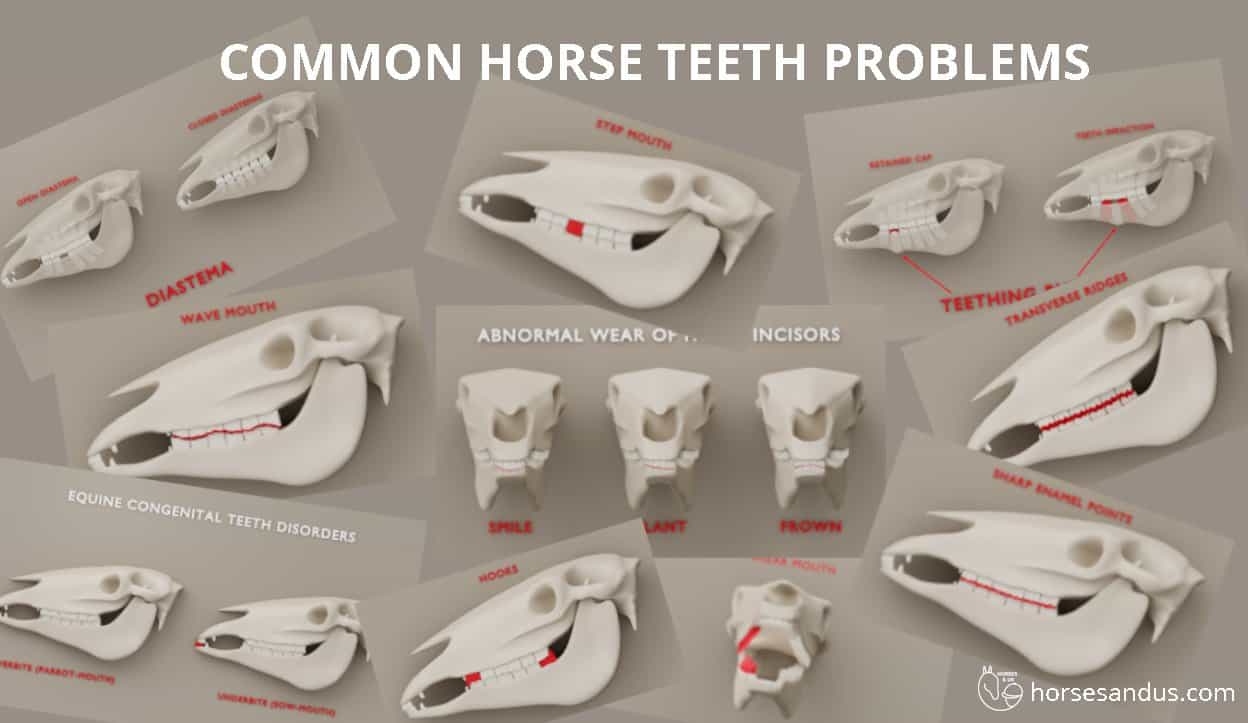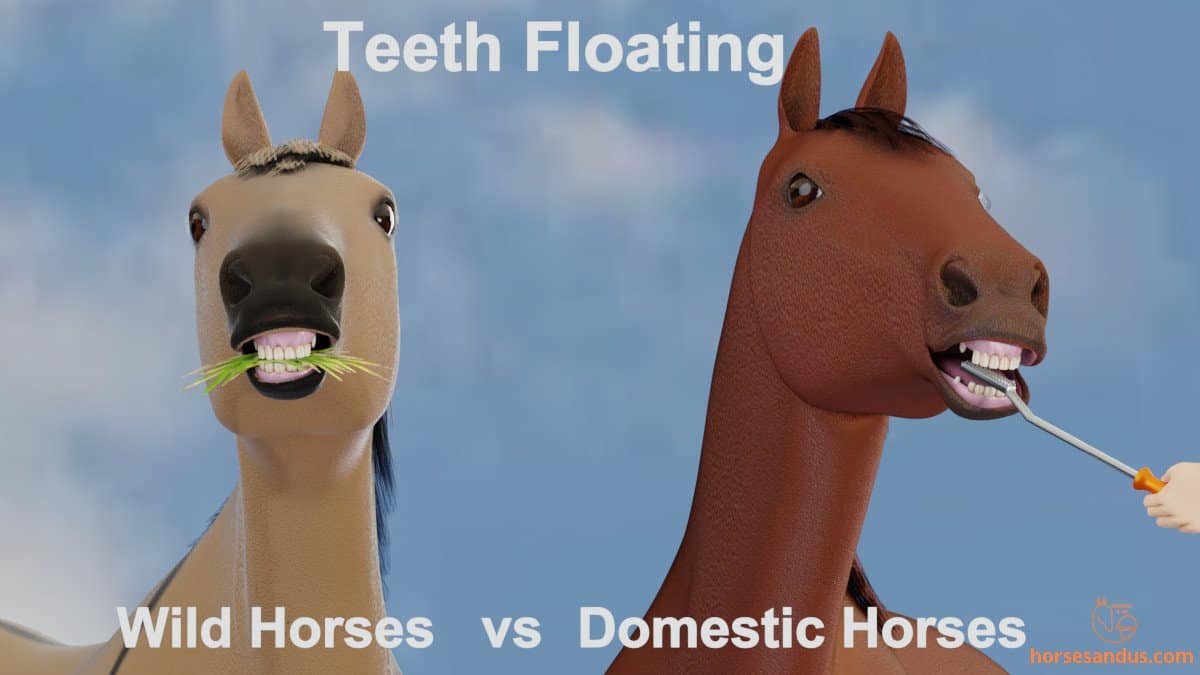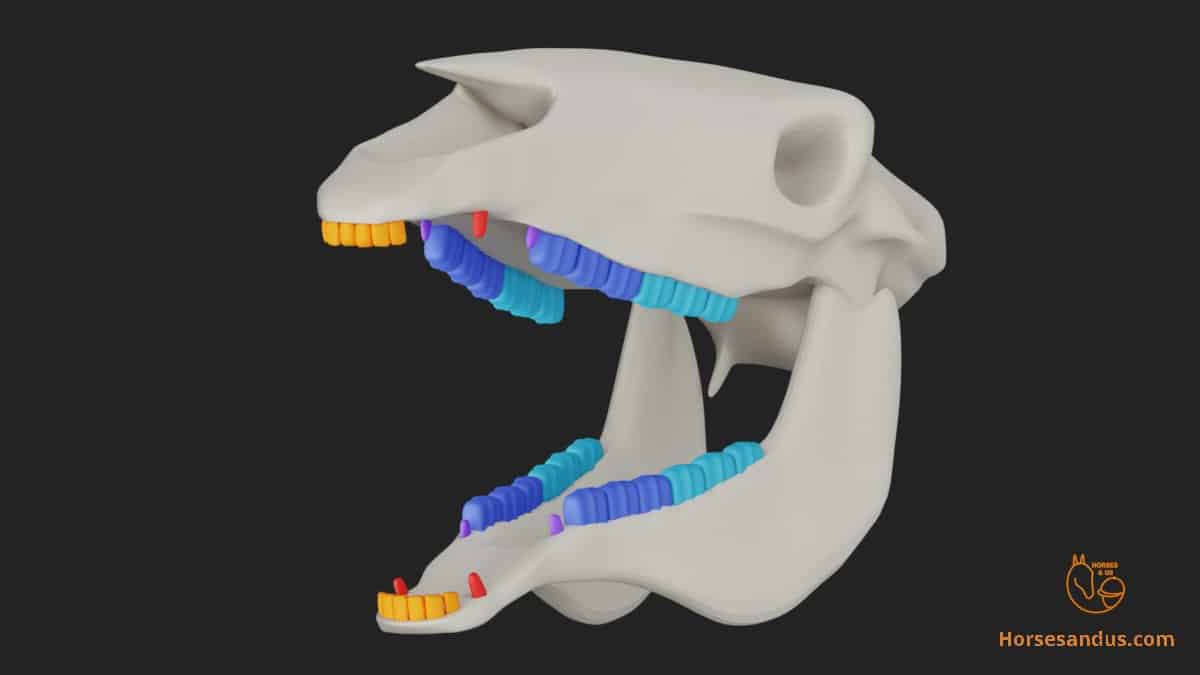An old-time adage “Don´t look a gift horse in the mouth” was born out of the fact that horses’ teeth are continuously changing throughout their lives and so can be used to estimate the horse’s age.
Until 5 years old, you can tell a horse’s age based on the teeth eruption, which has predictable time frames. After 5 years old, you can observe wear-related features that change as the horse gets older, such as shape, cups and dental stars, Galvayne’s groove, and incisors slope.
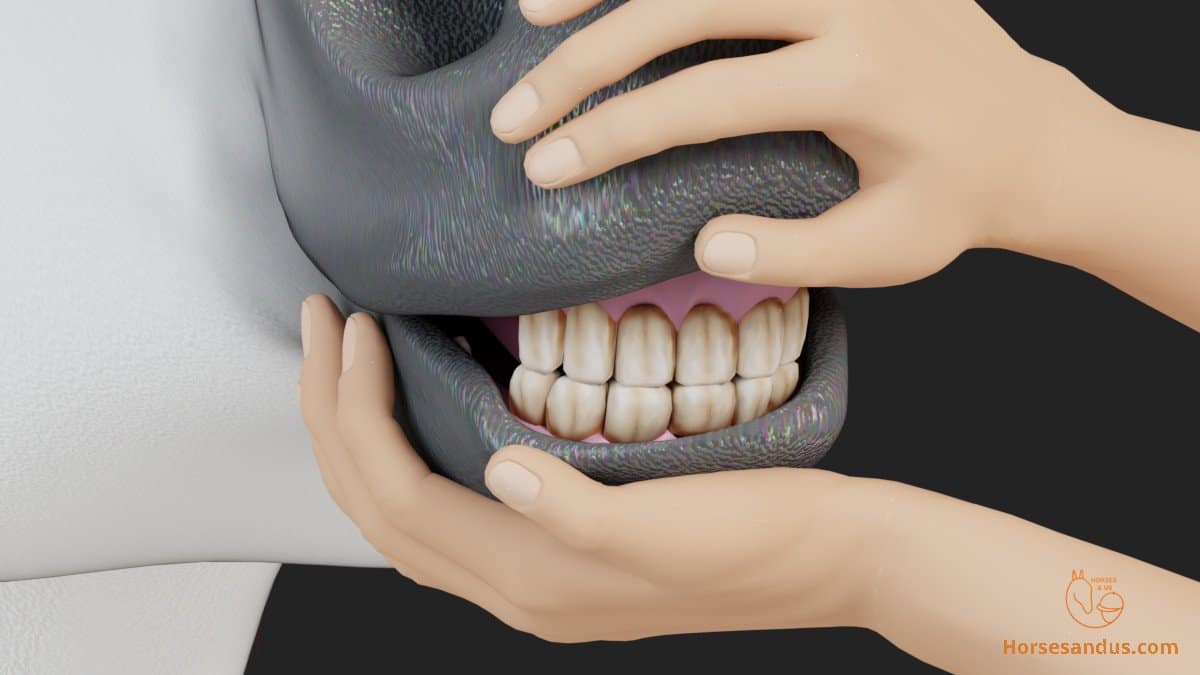
The most suitable teeth for aging a horse are the incisors. The cheek teeth can also be used, but their position makes observation more difficult.
Although not required, it may be helpful to read about Horse Teeth Anatomy And Function to understand this article better.
Aging A Horse Based On Teeth Eruption (Until 5 years)
Until the age of 5, estimating the horse’s age is relatively accurate because the teeth’ eruption has a rather predictable timing.
Horses have 2 sets of teeth during their lives, just as we do:
- A set of deciduous teeth (temporary baby teeth) that fall out.
- A set of permanent teeth (adult teeth) that erupt later.
Horse Teeth Eruption – Deciduous teeth (Baby Teeth)
Now let’s take a look at how many baby teeth a horse has and when they erupt.
Foals develop 24 deciduous teeth (baby teeth).
- 12 incisors
- 12 premolars
Deciduous teeth start to erupt before birth and continue until around 9 months of age.
The animation shows deciduous teeth erupting as the time progresses.
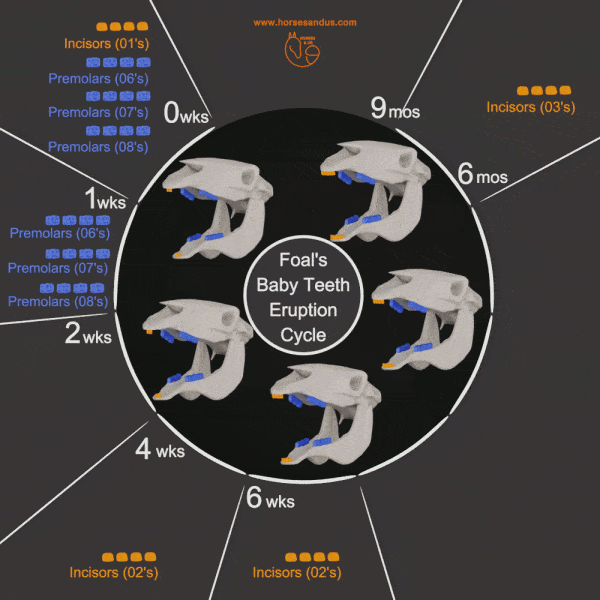
The chart below uses the triadan dental numbering system and shows the approximate ages of different teeth eruption. You can use it to detect potential abnormalities with your foal teething.

The horse will start to lose his deciduous teeth as the permanent teeth start to erupt in their place. However, in some cases, the deciduous teeth are retained, which creates a problem in the permanent teeth’ eruption.
Horse Teeth Eruption – Permanent Teeth (Adult Teeth)
Next we will see how many adult teeth a horse has and when they erupt.
There are a total of 36 to 44 permanent teeth (adult teeth):
- 12 incisors
- 12 premolars
- 12 molars
- 0 to 4 wolf teeth (usually 2)
- 0 or 4 canine teeth (usually only present in male horses)
Permanent teeth start to erupt around 1 year of age and continue until about 5 years of age.
The animation shows teeth erupting as the time progresses.

Using the triadan dental numbering system, the chart below shows the approximate ages of different teeth eruption. You can use it to detect potential abnormalities with your horse teething.

Aging A Horse Based On Teeth Wear (After 5 years)
After the age of 5, estimating the age of the horse is less reliable. But you can still make a rough estimation by observing some wear-related features that change as the horse grows older:
- Changes in the shape of the incisors
- Changes on the chewing surface (cups, marks, dental stars)
- Changes in the upper corner incisor (shape, Galvayne’s groove, and hook)
- The angle of incidence of the incisors.
Hypsodont Teeth
These changes happen because horses have hypsodont (long) teeth. The tooth’s reserve crown is hidden under the gumline and continues to erupt during the horse’s lifetime. The features of each tooth continuously change as new parts of the tooth appear above the gumline.
Estimating Age By Teeth Wear Is Not Completely Accurate
However, the teeth’ wear will vary for individual horses, breed, diet, health condition, and behaviors (ex: cribbing). This is why you cannot accurately determine the horse’s age based on the changes due to wear.
Nevertheless, observing these features can still give you a rough idea of how old the horse may be and can be useful when you buy or adopt an unregistered horse. Knowing the horse’s age, even if only approximately, is useful to plan a dental care schedule and the nutrition needs that vary with age.
The 4 Indicators Of Teeth Wear
The infographic below shows how the 4 indicators of teeth wear can determine a horse’s age.
- Shape of the incisors
- Markings on the surface
- Angle of incidence
- Changes on Upper Corner Incisor

1. Changes In The Shape Of The Horse’s Incisors
As the teeth progressively wear down, the shapes of the chewing (occlusal) surface change. They start with an oval (rectangular) shape in mesiodistal direction (from left to right), then become round, then triangular, and finally to an oval (biangular) shape again but now in the labiolingual direction (from front to back).

2. Changes Of The Marks On The Chewing Surface
The horse’s tooth structure is composed of 3 different substances: dentin, enamel, and cementum. The different hardness of these materials causes them to wear away at different rates (enamel slowest, dentin, and cementum fastest).
This explains why the chewing surface of the teeth have indentations. These indentations form the following marks.
“Cup”
The infundibulum is a funnel (an enamel infolding) in the equine incisor.
The upper part of the infundibulum is empty and is therefore called the “cup.” It fills with food particles giving it a dark brown appearance. The cup is encircled by an enamel ring, which is elevated above the surface.
As the teeth wear away, this cup will disappear and the horse is said to be “smooth mouthed”

“Mark” (enamel ring or enamel spot)
The lower part of the infundibulum is filled with cement (cementum). As the progressive wear gradually makes the cup disappear, the cement layer will appear at the surface. This exposed cement core, surrounded by an enamel ring, is called the “mark.”
Due to the slower wear of enamel than dentin and cementum, this ring is elevated above the surface.
As the tooth wears down, the enamel ring goes through shape changes (oval to triangular to round) similar to those of the incisors.
The enamel ring eventually disappears as the tooth wears below the infundibulum.

“Dental star”
As the tooth wears down, the pulp cavity gets filled with dentin. The “dental star” is the dentin that occludes the pulp cavity and protects it.
The dental star initially appears as a line in a young horse. As the tooth wears down, it gradually becomes oval and then round and moves towards the center of the chewing surface.
The dental star is the most reliable feature to determine the horse’s age.
The color of the dental star depends on the horse’s diet. Horses eating grass have dark-colored dental stars, while horses without access to grass have pale yellowish stars. This suggests that the color of the dental star is caused by grass pigments.
These progressive patterns reflect the cross sections of the pulp at various levels along the tooth.

3. The Angle Of Incidence of Horse’s Incisors
The angle of incidence refers to the meeting of the upper and lower incisor teeth when seen in profile view. As the horse ages, the angle of incidence gets progressively sharper (the teeth slope more).
In a young horse, the angle is almost 180º, but this angle becomes more acute as he gets older until approximately 90º in an older horse. Also, the tooth’s length gets bigger with age; that is why the expression “long in the tooth” is used to describe old horses.
The reason behind this is the shape of the incisor teeth, which are almost semicircular when the horse is young and gradually become shallower as he grows older.

4. Changes On The Upper Corner Incisor
Shape
When the horse is young, the upper corner incisor is wider than it is tall, then it appears square-shaped, and finally, it gets taller than wider.
Galvayne’s groove
As the horse’s upper corner incisor wears away, a vertical groove, filled with dark stained cementum, starts to appear on its outer surface. This is called Galvayne´s groove.
This groove starts to appear around 10 years of age and gradually extends to the tooth’s full length at 20 years of age. After this age, it will start to disappear near the gum line, then midway, and finally disappear completely.
However research has shown that the groove may be absent in many horses.

Hook
The dental hook is an overgrowth that is localized on the back margin of the horse´s upper corner incisors.
As the mouth changes shape (upper incisor tooth shape and the incisors’ incidence angle), the upper corner incisor’s back part will not contact the bottom corner incisor. So this back part of the tooth will wear more slowly, developing a hook overgrowth.
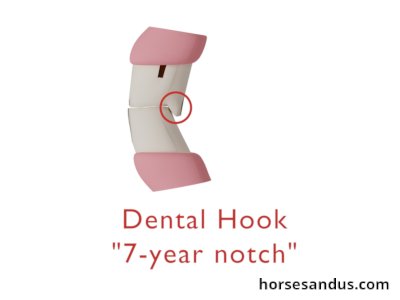
This hook usually first appears around the age of 7, and is thus called “7-year-notch”.
The hook may disappear and appear again at different ages. The hook will appear whenever the shape of the mouth changes such that upper and lower corner incisors do not fully contact each other.
Usually, it first appears at age 7 then disappears at age 9. It will reappear at age 11 and remain until the late teens and then disappear again.
Horse teeth Wear (animation)
Here’s a quick video showing how wear shortens the tooth and brings changes to the shape and marks on the incisors’ chewing surface. These changes are what enable you to age a horse by his teeth.
Sources
The following sources were used to research this article:
- Article from MSD vet manual
- Article from Researchgate
- Article From University of Missouri
- Article from US Department Of Agriculture
- Article from Science Direct
- The book: Equine Dentistry – by Jack Easley (Editor), Padraic M. Dixon (Editor), James Schumacher (Editor)
